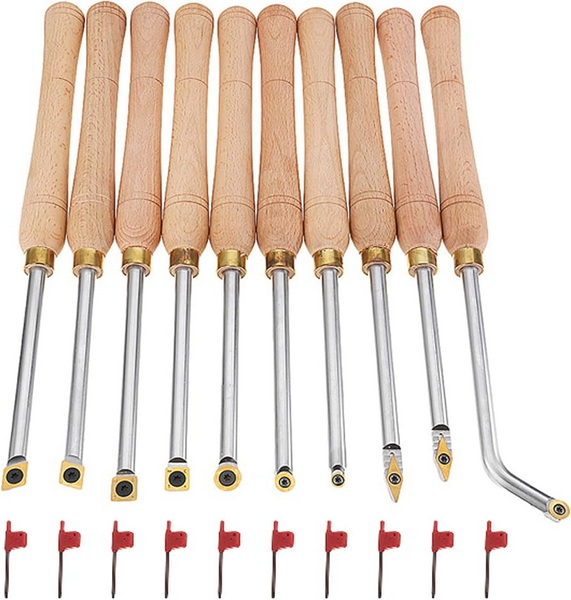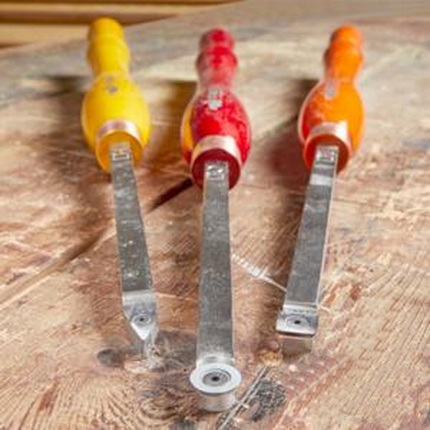Content Menu
● Understanding Carbide Tipped Wood Lathe Chisels
>> Benefits of Using Carbide Tipped Tools
● 1. Cleaning Your Carbide Tipped Wood Lathe Chisels
>> Steps to Clean
>> Importance of Regular Cleaning
● 2. Sharpening Carbide Tipped Chisels
>> Sharpening Techniques
>> When to Sharpen or Replace
● 3. Storing Your Chisels Properly
>> Storage Tips
>> Benefits of Proper Storage
● 4. Best Practices During Use
>> Usage Guidelines
>> Enhancing Your Technique
● 5. Common Issues and Troubleshooting
>> Problem: Dull Cutting Edge
>> Problem: Rust Formation
>> Problem: Chipped Tip
>> Problem: Vibration During Use
>> Problem: Tear-Out on Wood
● Conclusion
● Related Questions
>> 1. How often should I clean my carbide tipped wood lathe chisels?
>> 2. Can I sharpen carbide tipped chisels like traditional steel chisels?
>> 3. What are the advantages of using replaceable inserts?
>> 4. How do I know when my carbide tipped chisel needs replacing?
>> 5. Are there specific storage solutions recommended for these chisels?
Carbide tipped wood lathe chisels are essential tools for woodturners, providing a combination of durability, sharpness, and ease of use. Proper maintenance and care for these chisels are crucial for ensuring their longevity and performance. This comprehensive guide will cover everything you need to know about maintaining and caring for carbide tipped wood lathe chisels, including cleaning, sharpening, storage, and best practices during use.

Understanding Carbide Tipped Wood Lathe Chisels
Carbide tipped wood lathe chisels are designed with cutting tips made from carbide, a material known for its hardness and resistance to wear. Unlike traditional high-speed steel (HSS) tools, carbide tipped chisels maintain their sharpness longer and require less frequent sharpening. This makes them an excellent choice for both beginners and experienced woodturners.
Benefits of Using Carbide Tipped Tools
- Longer Edge Retention: Carbide tips stay sharp longer than traditional steel.
- Less Frequent Sharpening: Reduces downtime in your woodworking projects.
- Smooth Cuts: Provides a cleaner finish on your workpieces.
- Ease of Use: Ideal for both novice and professional woodturners.
- Versatility: Suitable for various types of wood and turning techniques.
1. Cleaning Your Carbide Tipped Wood Lathe Chisels
To maintain the performance of your carbide tipped wood lathe chisels, regular cleaning is essential. After each use, follow these steps:
Steps to Clean
1. Remove Sawdust: Use a soft brush or compressed air to remove sawdust from the chisel. This prevents debris from scratching the surface or affecting performance.
2. Wipe Down: Use a clean cloth dampened with mineral spirits or rubbing alcohol to wipe the chisel's surface. This helps remove any resin or pitch that may have accumulated during use.
3. Dry Thoroughly: Ensure the chisel is completely dry before storing it to prevent rust. A quick air blast can help remove moisture from hard-to-reach areas.
Importance of Regular Cleaning
Regular cleaning not only prolongs the life of your chisels but also ensures they perform at their best. Residue buildup can lead to poor cutting performance and can even cause damage over time.
2. Sharpening Carbide Tipped Chisels
While carbide tips do not require traditional sharpening like HSS tools, they can become dull over time due to regular use. Here's how to maintain their sharpness:
Sharpening Techniques
- Use a Diamond File: For minor touch-ups, use a fine diamond file to hone the edge. This method is quick and effective for maintaining the cutting edge.
- Replaceable Inserts: Many carbide tipped tools feature replaceable inserts; when dull, simply replace the insert instead of sharpening. This is one of the key advantages of using carbide tipped chisels, as it saves time and effort.
When to Sharpen or Replace
You should sharpen or replace your chisels when you notice a decrease in cutting efficiency or if you experience tear-out on your workpieces. Regular inspection will help you catch these issues early.
3. Storing Your Chisels Properly
Proper storage is crucial in maintaining the integrity of your carbide tipped wood lathe chisels. Follow these guidelines:
Storage Tips
- Use a Tool Rack: Store chisels in a dedicated tool rack or drawer to prevent damage. A well-organized workspace not only protects your tools but also enhances efficiency during projects.
- Protect the Edges: Consider using protective sheaths or covers for the tips to avoid accidental damage. This is especially important if you store your chisels in a drawer with other tools.
- Keep Dry: Ensure that your storage area is dry to prevent moisture buildup, which can lead to rust formation on any exposed metal parts.
Benefits of Proper Storage
Proper storage helps maintain the sharpness of your chisels and prevents physical damage that can occur during handling or transport.

4. Best Practices During Use
Using your carbide tipped wood lathe chisels correctly can minimize wear and tear:
Usage Guidelines
- Correct Angle: Maintain the appropriate angle while cutting to reduce stress on the tip. The ideal angle varies depending on the type of cut you are making but generally falls between 20° to 30°.
- Avoid Excessive Force: Let the tool do the work; excessive force can chip or break the carbide tip. If you find yourself applying too much pressure, it may indicate that your technique needs adjustment or that the tool needs maintenance.
- Regular Inspection: Periodically check your chisels for any signs of wear or damage before starting a new project. Catching issues early can save you time and money in repairs or replacements.
Enhancing Your Technique
Improving your technique not only prolongs the life of your tools but also enhances the quality of your workpieces. Consider taking classes or watching instructional videos on proper woodturning techniques.
5. Common Issues and Troubleshooting
Even with proper care, you may encounter issues with your carbide tipped wood lathe chisels. Here are some common problems and solutions:
Problem: Dull Cutting Edge
- Solution: Use a diamond file for minor touch-ups or replace the insert if applicable.
Problem: Rust Formation
- Solution: Clean and dry your chisels after each use; apply a light coat of oil if necessary to protect against moisture.
Problem: Chipped Tip
- Solution: Inspect regularly and avoid excessive force during use; consider replacing if damage is severe.
Problem: Vibration During Use
- Solution: Ensure that your lathe is properly calibrated and that your workpiece is securely mounted to minimize vibration that can affect cutting performance.
Problem: Tear-Out on Wood
- Solution: Adjust your cutting angle or speed; using sharper tools typically reduces tear-out significantly.
Conclusion
Maintaining and caring for carbide tipped wood lathe chisels is essential for achieving optimal performance in your woodworking projects. By following proper cleaning, sharpening, storage, and usage practices, you can extend the life of your tools and enhance your woodworking experience. Remember that these tools are an investment in your craft; treating them with care will pay off in smoother cuts and more enjoyable projects.
Investing time in learning about proper maintenance techniques will not only improve the lifespan of your carbide tipped wood lathe chisels but also elevate the quality of your craftsmanship over time.

Related Questions
1. How often should I clean my carbide tipped wood lathe chisels?
Cleaning should be done after each use to remove sawdust and prevent buildup that can affect performance.
2. Can I sharpen carbide tipped chisels like traditional steel chisels?
No, carbide tips require different maintenance; they can be honed with diamond files or replaced if they become dull.
3. What are the advantages of using replaceable inserts?
Replaceable inserts allow you to maintain sharpness without needing extensive sharpening skills or tools.
4. How do I know when my carbide tipped chisel needs replacing?
If you notice significant wear on the cutting edge or if it fails to cut smoothly despite cleaning and honing, it may be time to replace it.
5. Are there specific storage solutions recommended for these chisels?
Using a dedicated tool rack or drawer with protective sheaths is recommended to keep them safe from damage.
















